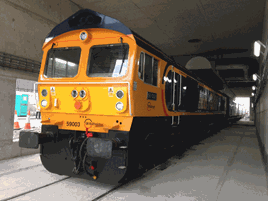Freight has had to battle for paths on the various lines that criss-cross the region, linking some of the UK’s busiest and most populated cities - Leeds, Sheffield and Manchester, as well as (further afield) Liverpool, Hull, Bradford, York and Newcastle.
It was two years ago that Drax began working with Network Rail and GBRf, identifying paths that were viable and which could support a train plan to and from the Port of Liverpool. Since then, GBRf has been working on making that a reality.
At the launch of the train, Smith said: “The running of the first biomass train for Drax Power from the Port of Liverpool is an important moment for GB Railfreight. Over the last two years, we have been working with Drax and the infrastructure operator to secure viable paths across the trans-Pennine rail network, and answer the demands of one of our longest and most loyal customers.
“Today is recognition of these efforts and the innovative approach we take to customer solutions. We’re looking forward to building on this relationship with Drax as we move into Phase 2 of the Liverpool project.”
Drax Head of Supply Chain & Logistics Graham Backhouse said: “This first delivery of sustainable biomass from the Port of Liverpool is further evidence of Drax powering the Northern Powerhouse.
“Using cutting-edge biomass technology we are transforming the UK’s largest power station into one of Europe’s largest generators of renewable electricity. Receiving biomass from Liverpool is another example of how we provide the UK with sustainable, reliable and affordable energy.”
At Drax there are six generators - three are biomass-powered and the rest are coal-powered. Drax Power aims to convert a fourth to be powered by biomass. This could result in even more traffic.
The route the trains take is certainly a circuitous one. Once the trains have climbed from the Port, they use Tuebrook sidings, which have been upgraded with staff facilities built there.
Smith explains: “Tuebrook is odd. The sidings have been used for tamper maintenance. They are on the right near Edge Hill. There used to be a tunnel that went to the Docks, and the locomotive runs into that a short distance. It runs round the train there. There are three sidings, and these were last used for electrification.”
He says the train arrives hauled by the ‘59’, which is unhooked and runs into the tunnel before a ‘66’ then takes the train to Drax. The ‘59’ is then attached to the next train to the Port, and the process begins again.
The biomass trains run from Liverpool to Warrington, then across to Northwich, Altrincham, Stockport and Rochdale. From there they head across the Calder Valley and then on to Wakefield, Knottingley and Drax. It is a 99-mile journey.
GBRf says that initially 13 trains per week will run, rising to 23 from mid-2016. The wagons are owned by Drax and have a capacity for 116 tonnes of product - 30% more than other UK wagons. The payload is 72t with a gross laden weight of 102 tonnes. Maximum speed is 75mph.















Login to comment
Comments
FrankH - 02/02/2016 11:35
Another route could be to Warrington BQ as now then WCML to Farington Jnct then the East Lancs line via copy pit into yorkshire rejoining the original route at Wakefield. Maybe longer mileage wise but there's not a lot of traffic uses the route.
FrankH - 03/02/2016 12:03
There's a Doncaster -Preston - Doncaster light engine move via the copy pit route 2nd and 3rd Feb, It could be GBRF route training as Colas allready run this way with bitumin for preston docks.
FrankH - 28/02/2016 23:17
The first time I've seen it in the schedule, Doncaster Decoy yard via calder valley to Farington jnct, WCML to parkside Jnct then St Helens to Liverpool Bulk terminal. 3hrs 20 mins.